
KNOWLEDGE
UNESCO Awarded Nuad Thai, traditional Thai massage
Thailand
Inscribed in 2019 (14.COM) on the Representative List of the Intangible Cultural Heritage of Humanity
Nuad Thai, traditional Thai massage is regarded as part of the art, science and culture of traditional Thai healthcare. As a non-medicinal remedy and manual therapy, it involves bodily manipulation in which the practitioner helps rebalance the patient's body, energy and structure to treat illnesses believed to be caused by the obstruction of energy flow along 'sen', lines understood to crisscross the human body. This manipulation is intended to normalize the four body elements: earth, water, wind and fire. To open up blocked routes, Nuad Thai therapists perform a combination of manipulations using their hands, elbows, knees and feet, together with herbal hot compresses to reduce inflammation. Presently, Nuad Thai is classified into two main types: Nuad Thai therapy and Nuad Thai for health promotion. Nuad Thai has its roots in self-care in Thai peasant society of the past; every village had massage healers whom villagers would turn to when they had muscle aches from working in the field. Over time, these experiences have evolved into a formal system of knowledge, and Nuad Thai is now an income-generating occupation. In 1985, the Project for the Revitalization of Thai Massage was launched to revitalize and maximize knowledge of Nuad Thai, and an initiative has also been taken to form an alliance of Nuad Thai practitioners who come together annually.
Reference: https://ich.unesco.org/en/RL/nuad-thai-traditional-thai-massage-01384
The therapist in the video above Sam-arng Saowamarn is at Wat Nong Ya Nang, the temple of our late Monk teacher. He is the disciple of the Late Monk the same time of Arjan Tuan – our teacher. This temple is where we trained for Nuad Thai – or Thai massage therapeutic and apply the learning to our students at TMC since the founding 2001.
Nuad Thai various techniques are written in "Ancient Thai Massage Healing With Prana 4th Edition". The text book is being used for Thai massage learning at TMC school. The treatment used with rail and Yam Khang and therapeutic massage at Wat Nong Ya Nang are being taught in classes at TMC school. (See chapter 11 in the book.) TMC School built rails for this therapeutic technique for the advanced class (page 145).
One can obtain complete information mentioned in the video presented by UNESCO in the most comprehensive Thai massage book with thorough research on history, healing data, medical study research and various techniques on Nuad Thai – Thai therapeutic massage—by the co-founders of the Royal Awarded Thai massage school in Thailand—the books is "Ancient Thai Massage Healing With Prana 4th Edition: Second Printing" at www.thaimassagebook.com
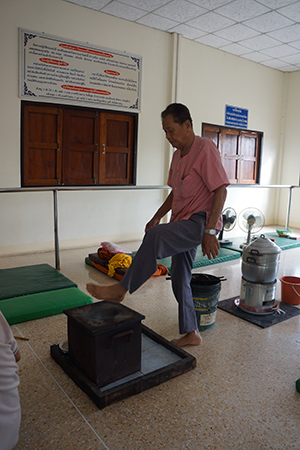
Mor Sam-arng treated a stroke patient at the temple Wat Nong Ya Nang with Nuad Thai using rail and Yam Lek Dang.
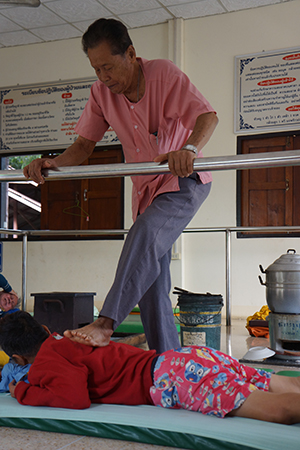
Step on muscle area on the back to release tension.
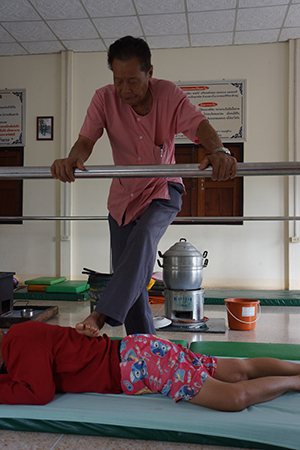
The pressure will not be on the spine to avoid damage.

Nuad – massage on paralyzed arm.
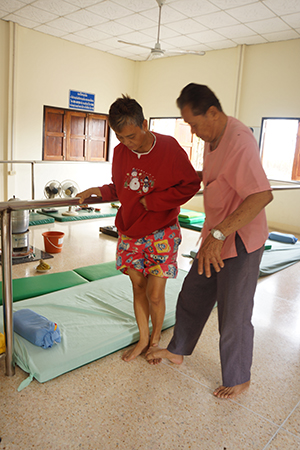
After a few treatments, the patient is able to be train to walk using rail with support.

TMC Co-founder Jan with Mor Sam-arng at the visit in 2015.
Link to BBC "The birthplace of traditional Thai massage"
Interviewed Wat Pho and TMC.
Theory of Sen Sib
The philosophical theory of Thai massage is similar to that of Ayurvedic massage which is based on the life energy channels and the belief that a person's health and wellbeing relies on the balance of life energy. Life energy in Thai massage is called "Prana", which means "the wind of life", and is known as "Lom Pran" in Thai. An obstruction in the flow of Prana can cause discomfort or illness to a person. As Sen Sib are the major energy channels throughout the body, they need regular maintenance to avoid any blockage or stagnation.
Applied properly, Thai massage helps immensely in removing blockages that could obstruct
the energy flow in the Sen Sib, and bring balance to body, mind and spirit. See "Energy Blockage Relief: Free Flow of Prana" in chapter 6 (Ancient Thai Massage Healing with Prana). The ancient Thais applied pressure on points according to Sen Sib in combination with herbal medicine application to treat certain illnesses. Nowadays, some of these pressure points are being used in therapeutic massage to relieve common ailments.
Characteristics of Sen Sib
- There are ten major paths. "Sen" means path or line and "Sib" means ten.
- All ten Sen originate approximately two inches below the abdominal surface in the vicinity of the navel.
- Each Sen has a different gate throughout the body.
- The paths are invisible. They are not blood vessels, nerve fibers, or ligaments as many may think. They are invisibly connected to send sensations when pressure is applied at the right point to the corresponding directions.
- There is "wind" being the energy force that runs through the path. If the path is blocked, obstruction to the wind can cause illness. Some paths have more than one type of wind. Some have names for the winds and others do not. However, if there is no name of the wind for a path, it does not mean there is no wind. The ancients simply did not give names to some winds, but symptoms can still appear when there are blockages of winds in those particular Sen lines.
- The paths have pressure point locations that affect the wind when pressed.
The names of Sen Sib are
- Ida
- Pingala
- Summana
- Ganlataree
- Hadsarangsri
- Tawaree
- Jantapusank
- Rusam
- Sukumang
- Si-ki-nee
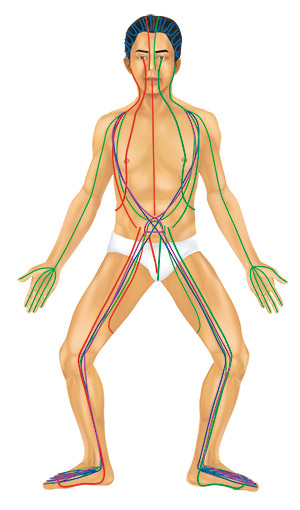
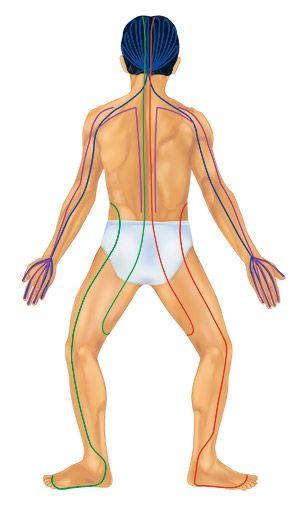
Sen Sib Channels front and back
Reference
Jan Chaithavuthi and Kanchanoo Muangsiri (2016) Ancient Thai Massage Healing with Prana – Edition 4, Chiang Mai, Thai Massage Book Press
Thai Massage Revival Project
The overall public concern of safety in Thai massage is an important issue since people with inadequate knowledge are nowadays using incorrect Thai massage techniques. This can cause harm to the recipient, sometimes seriously to the point of death or paralysis. These harmful effects can result from improper stretching techniques and/or severe massage on endangered areas such as the neck. Also, too much pressure can cause damage to nerves on other parts of the body.
The reputation and image of Thai massage began to decline after the Vietnam War in the 1960s when the name was marred as a sex image; resulting in the need to nurture this ancient art back to its former worthiness.
In 1985, the Thai government supported a special task force named "The Thai Massage Revival Project" (TMRP) composed of twelve resource organizations representing various fields, namely alternative medicine, public health, Thai massage associations, Thai traditional medicine organizations, health offices, medical doctor foundations, and temples famous for therapeutic massage.
The project was implemented on 15 November 1985. Chairman of the project, Professor Prawase Wasi, M.D. presided over the inaugural meeting at the Public Relations Department in Bangkok for the historical moment of the reviving of Thai massage. In his speech:
"… we believe the development must base on interrelation of righteousness, humanity, culture and tradition, education, and economy— all must unite and be well balanced in order to alleviate suffering and able to console and support mankind…"
This was the first time that the nation's twelve most respected Thai massage practitioners and teachers met and discussed the future of Thai massage. The result of the meeting was to pursue Thai massage revival with the support and cooperation of all concerned.
The Outcome of the Thai Massage Revival Project Research
A curriculum of the original Foundation of Thai Massage covering the entire ten major life energy lines (Sen Sib) has been established. The curriculum is comprised of fascinating Thai massage techniques that combine the best of both styles from Royal Thai massage and Folk Thai Massage. Folk Thai Massage for the general people contains techniques that may be considered impolite when used with people in high status, and some stretching techniques may be somewhat unsafe to the recipient. Nevertheless, the beneficial side of this style is that it is comprised of genuine Thai massage techniques and is easier for the learner. It emphasizes energy contact for both the giver and the recipient. Royal Thai Massage, however, is presented in a manner that reflects a polite and for therapeutic nature. The use of thumbs to press on the therapeutic points and stimulate the Sen Sib is suitable for the polite Thai way. As a result, the life energy lines are more stimulated using pressure points than in the stretching position.
Research conducted by TMRP changed the view of Folk Thai Massage showing that it can be as polite, safe and effective as the Royal Thai massage when positions are carefully selected and using the techniques to perform it.
After several meetings, the curriculum was drafted and tested in communities and community hospitals for therapeutic purposes. It was then evaluated and revised to perfection and put into use nationwide as a training model. Many people in communities throughout the country have been trained to apply knowledge and perform safe massage in their family or as a profession. Results show that nationwide practice in hospitals and health care centers around the country have brought satisfaction to the public and it is widely accepted by public health care providers.

Samples of research and books by
Health and Development Foundation (HDF)
Advisors and Teachers in the Thai Massage Revival Project
Advisors
1. Phrakhru Uppakarn Phatanakit (1946 - 2013)
2. Assistant Professor Sumlee Jaidee
3. Ajarn Pisit Benjamonkkolwaree (Deceased)
Teachers
1. Ajarn Tuan Ruangyoo
2. Ajarn Boontum Kitniyom
3. Ajarn Ubol Huadhongtong (Deceased)
4. Ajarn Somboon Tosomboon (Deceased)
5. Ajarn Sompod Sririwat (Deceased)
6. Ajarn Pratin Subboonmee
7. Ajarn Tawin Apainikom
8. Ajarn Lau Janieam
9. Ajarn Suthee L erdpanprom (Deceased)
10. Ajarn Jumlong Prommin
11. Ajarn Somkiat Kongwittaya
12. Ajarn Kanit Kamapanmanas
Note: "Ajarn" (from Sanskrit Acharaya) is the title given by Thais to academic masters, similar to the word "Khru" (from Sanskrit Guru).
Organizations in the Thai Massage Revival Project 1987
1. Health and Development Foundation
2. Medical Problem Study Group
3. Folk Medicine Doctor Foundation
4. Coordination Committee of Non Government Organizations for Basic Health Care
5. Thai Traditional Medicine Association Thailand, Wat Parinayok
6. Traditional Thai Pharmacy and Ayurvedic Medicine Thailand, Wat Samphraya
7. Thai Traditional Medicine Association, Wat Mahathart
8. Thai Massage Profession Conservation Association, Wat Arwutwikasitaram
9. Wat Nong Yanang
10. Thai Massage Development Study Group
11. Office of Basic Health Care Committee, Ministry of Public Health
12. Health Care Office, Bangkok Metropolitan Municipality
Reference
Jan Chaithavuthi and Kanchanoo Muangsiri (2016) Ancient Thai Massage Healing with Prana – Edition 4, Chiang Mai, Thai Massage Book Press
Types of Thai Massage
Types of Thai Massage—The True Meaning
In some instruction manuals on Thai massage, western authors have observed differences
among techniques used by various practitioners and teachers and thus refer to a Northern
style of massage as practiced in the northern region, especially in Chiang Mai, and a Southern style for massage practiced in Bangkok or at Wat Pho.
However, according to ancient teachers, Thai massage was not, in fact, divided into types, but variation in techniques depending on practitioners or teachers. Even though they follow the same basic massage principles, practitioners might emphasize different modalities. For example, some may focus on stretching while others may focus more on pressure points.
The ancient practitioners revised the techniques to be more suitable for the members of the royal family and high ranking officials as they required respect, politeness, precision, and effective handling when applying pressure points in a relatively short session. Later on, Thai massage scholars named this revised massage technique as " Nuad Rajchasumnak" or"Royal Thai Massage". They then named general massage as " Nuad Chaleoysak" or " Folk Thai Massage", which means a kind of massage that aimed at the general public.
Both techniques are composed of the same principle of lines theory but employ a different approach.
Characteristics of Royal Thai MassageThe practitioner uses only hands, heels of hands, and primarily thumbs, when performing. This application aims to apply pressures directly on each therapeutic pressure point according to the ancient massage treatment tablets.
This is why one of the entrance requirements for the learner is to have strong hands and fingers. Some schools test students' ability by asking them to perform "floor lifting", this means lifting up one's body with fingers pressed on the floor while sitting in a cross-legged position.

Royal Style Thai massage keeps at arm's length distance
Characteristics of Folk Thai Massage
The practitioner uses the thumbs, fingers, hands, lower palms, elbows, arms, knees, and feet to perform the massage. This helps lessen stress on practitioner's thumbs and hands and also enhances the pressure strength.
The practitioner maintains closer contact with recipient than in Royal Thai Massage. It is also helpful and effective when using different parts of the body as a tool to give massage. Appropriate contact is certainly important to maintain the manners of massage. This free style massage sometimes leads to impoliteness and brings criticism and creates a negative image to Thai massage.
Most Folk Thai Massage commences at the feet and progress in an upward direction. However, there is no strict rule that massage cannot start from the head and move downward to end at the feet.
Folk Thai Massage is performed with all four main positions, lying face down (prone), lying on one's back (supine), on the side, and in the seated position unlike Royal Thai Massage that avoids the prone position. The stretching positions are the charm of Thai massage and can bring both joy and benefits. At the same time, however, they can be harmful to the recipient if performed incorrectly.
This leads to regulation and licensing in Thai massage by the Ministry of Public Health.
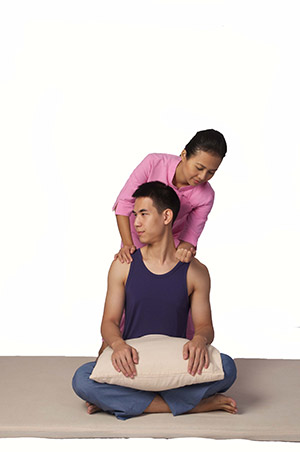
Folk style Thai massage can remain polite
with guarded movement
Reference
Jan Chaithavuthi and Kanchanoo Muangsiri (2016) Ancient Thai Massage Healing with Prana – Edition 4, Chiang Mai, Thai Massage Book Press
Good Quality Thai Massage: Safe, Polite and Effective
Safe refers to causing no harm to the receiver during and after massage and ensuring that the symptoms do not worsen.
Politeness refers to manners and appearance of the giver and the receiver.
Effectiveness refers to a good result or outcome from the massage session provided within a certain time limit.
Techniques for a Good Quality Massage
Knowledge and skill are the major factors for a quality massage. Be observant; learn from mistakes, follow up massage results, gain sincere feedback, continue to seek knowledge from experienced worthwhile resources in order to become a professional.
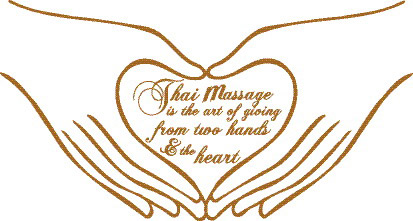
Reference
Jan Chaithavuthi and Kanchanoo Muangsiri (2016) Ancient Thai Massage Healing with Prana – Edition 4, Chiang Mai, Thai Massage Book Press
Luesri Dadton—Yogi Exercise
Yogi Exercise is the premier of the Thai massage art. A routine for Thai massage students
is to start the training by performing Yogi exercise to prepare the body and mind
ready for learning that day. Many Thais are also practice Yogi exercise as their daily routine.
The real benefit of yogi exercise beside the body movement is at the breathing, tensing
and relaxing the part of the body. When tensing the part of the body in particular position, the
practitioner should inhale and hold the breath in tense mode. At the relaxing of the tension,
exhale with the releasing of the tension.
The action of tensing with proper breathing would facilitate greater oxygenation of the
blood enhancing waves of circulation throughout the body. Thus, promote healing and wellbeing.
Furthermore, the yogi exercise is a self- vertebral adjustment to relieve pressure on the
nerve between the vertebrae. It creates proper body alignment and strengthen muscle along the
spine and other parts of the body.
Yogi exercise has proven to benefit the practitioner by strengthening the body, calm
the mind and enhancing the spirit. Some studies have shown the exercise could benefit people
in their routine lives, to the persons with physical weakness and to the one with sickness, all
may find some relief from the ancient exercise.
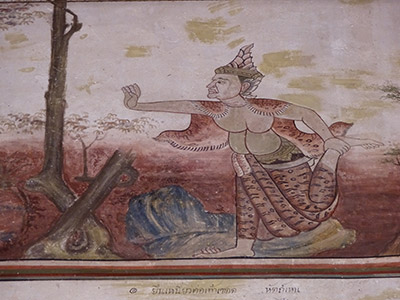 Wall painting of Luesri Dadton, Wat Matchimawad, Songkhla |
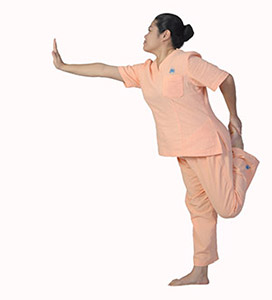 Yogi Exercise to relieve chest pain |
Reference
Jan Chaithavuthi and Kanchanoo Muangsiri (2016) Ancient Thai Massage Healing with Prana – Edition 4, Chiang Mai, Thai Massage Book Press
Tok Sen: the Massage with Vibration and Sound Therapy
Tok Sen is an art of Thai traditional local wisdom like Yam Khang and has no record of whom or when it started. The name implies direct meaning of the treatment: Tok means hammering and Sen means line – massage line. Hammer "Tok" on the line "Sen" of the muscle.
The tool is a wooden hammer and a thick wooden stick to pound on. The technique is still considered sacred among Thai practitioners but with easy access to the application.
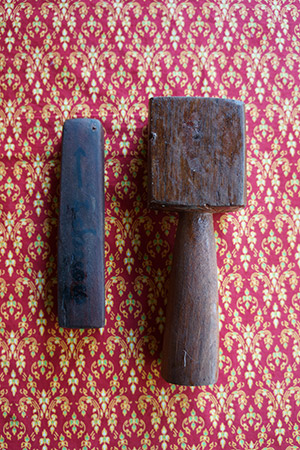 Wooden hammer and stick |
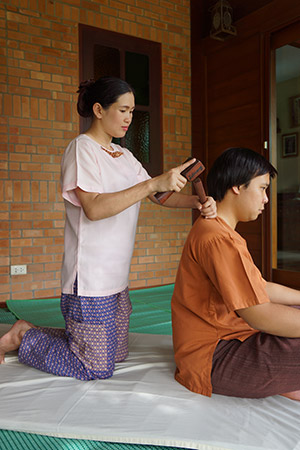 The practitioner applies Tok Sen on the shoulder |
The Healing Approach
Tok Sen becomes an important part of Thai local wisdom in Thai massage. The practice spreads in most region of Thailand but more so in the north. Thais do belief that the hammer and the wooden stick are sacred tool and some teachers engrave or write mantra in Pali or in Lanna alphabets on them. Some even seek certain type of tree for the set especially the tree struck by lightning.
Mantra is a significant part of practitioners who believe in it and recited prior to the start of the treatment.
The Benefit from the Treatment
To the body: Tok Sen is like therapeutic Thai massage but instead of using thumb to press on the therapeutic points, the hammer on the stick is acting like the pressing thumb. The pressure applies on the point is compounded by the repeat of the beating usually 1-2-3 beating on each spot. The pressure felt on the area is rather different from by the thumb.83 The pounding creates the vibration that radiate through the muscle. The effect to the muscle is about the same with thumb pressing and circling at the same time. To the practitioner, it is not only a relief on the thumbs, but it is also able to continue applying pressure to the therapeutic points.
To the mind: The belief in the tool and techniques pave the way to healing and producing effective result. The sound produced from hammering on the stick is another form of healing – sound therapy. Sound healing is one form of healings to mankind85 whether from reciting mantra, hitting the bronze bell at the temples, Tibetan Singing Bowls, music, or the technique of Tok Sen.
Tok Sen is an overall healing for ache and pain, muscle stiff, back pain, office syndrome, stroke – paralysis, enforcement on particular therapeutic points and even for relaxation and well being.
Reference
Jan Chaithavuthi and Kanchanoo Muangsiri (2016) Ancient Thai Massage Healing with Prana – Edition 4, Chiang Mai, Thai Massage Book Press
Thai Massage and Herbal Ball Application—the Great Pair
Herbs remedy is the key ingredient in Thai traditional medicine. However, the use of it requires medicinal knowledge and the obtaining of the herbs which may be untimely to offer massage. Herbal ball is the answer and a quick fix for all concerned. The application of The herbs being used does not require Thai Traditional Medicine license and the availability is within reach unlike the herbs medicine applied orally.
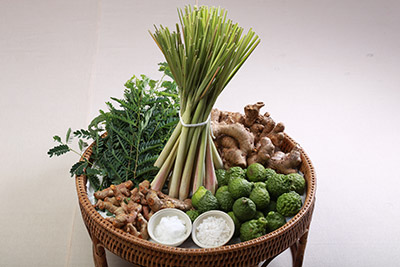 Herbal ball ingredients |
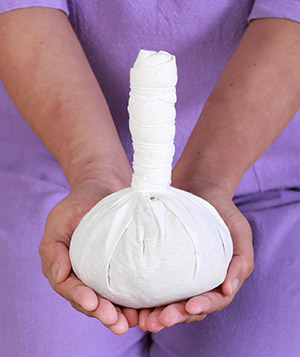 Herbal Ball |
Benefits of Herbal Ball Application to Thai Massage
It is a complementary treatment with Thai massage and Thai traditional medicine since the ancient era. The direct means are the heat and the compression that bring direct relief and indirect results. The treatment with herbal ball reduces chronic inflammation on muscle ligament and joints, improves spasticity, enhances elasticity on muscle, releases stiffness on muscle and joints, eliminates pain and stimulates circulation to boost healing.
The characteristics of the herbal ball that provide several benefits to healing stem from
the herbs properties; the temperature of about 40-45°c and this type of heat can penetrate
the skin about 1 centimeter from the surface.
Herbal ball application alone can yield impressive benefit to the recipients as shown in
these studies:
Subject: The Effect of Herbal Ball Application to Reduce Pain on Persons with Chronic Degenerative Inflammation Knees
Journal of Thai Traditional & Alternative Medicine Vol. 6, No.2 May-August (supplement)
2008, page 89 No: OR-49 by Surat Lekuthai, et al. At Damnoen Saduak Hospital, Ratchaburi
Province.
Treatment/outcome: Number of participants 30 adults: Divided in 3 groups 10 persons each.
Group 1 received herbal ball application on the affected knee daily lasted 30 minutes for
5 days. Group 2 received the same treatment but by hot compress – not herbal ball. Group 3
received knee exercise instructed by the research team 30 minutes daily for 5 days. The
outcome indicated all 3 groups showed reduction of pain and improved in the ease of their activities.
However, the first group received herbal ball application showed faster reduction of pain
than the other groups.
Subject: The Effect of Herbal Ball Application to Reduce the Use of Pain Medication on Diabetic Persons with Chronic Degenerative Inflammation Knees
Journal of Thai Traditional & AlternativeMedicine Vol. 12, No.2 May-August (supplement)
2014, page 38 No: PP1994RC by Soraya Sanisi. At Tumbon Dan Health Care Hospital, Rasi Salai
District, Si Saket Province.
Treatment/outcome: Number of participants 20 diabetic adults normally requested pain
medication for the knee pain. The participants received herbal ball application 15 minutes
one day, then received 3 times for another week. After which the participants were trained how
to heat and apply the herbal ball at home twice daily, in the morning and evening for 10 minute
each session.
The measurement was done by interview and pain scale (VAS) and the outcome indicated
that before the study on the first month, the pain scale was average at 7.80 compare to after
the fourth month reduced to an average of 3.90. The request for pain medication also dropped
after the first month to 13 persons from 20 persons and to only 7 persons at the end of
the study.
The next studies are the combination of Thai massage with herbal ball application to reduce pain.
Subject: The Effect of Thai Massage and Herbal Ball Application to Reduce Migraine Headache
Journal of Thai Traditional & Alternative Medicine Vol. 12, No.2 May-August (supplement)
2014, page 34 No: PP1987RC by Itthipon Taaut. At Rasi Salai Hospital, Si Saket Province.
Treatment/outcome: Number of 30 participants with diagnosis of migraine. The participants
agreed not to undergo other treatment or taking medicine other than prescribed
by the physician at the hospital while under the study. The participants received Thai massage
with herbal ball application lasted 45 minute each for 3 sessions every other day. The level
of pain before the study averaged at 6.07 compared with after the third treatment averaged at 3.63.
Subject: The Effect of Thai Massage and Herbal Ball Application to Reduce Lower Back Pain
Journal of Thai Traditional & Alternative Medicine Vol. 12, No.2 May-August (supplement)
2014, page 35 No: PP1989RC by Maliwan Kaewpradap. At Rasi Salai Hospital, Si Saket
Province.
Treatment/outcome: Number of 30 participants with diagnosis of lower back pain. The
participants received Thai massage for 35 minutes and herbal ball application another
10 minute each for 3 sessions. The level of pain before the study averaged at 7.73 compared
with after the third treatment averaged at 4.53.

Herbal ball compress on the back
Reference
Jan Chaithavuthi and Kanchanoo Muangsiri (2016) Ancient Thai Massage Healing with Prana – Edition 4, Chiang Mai, Thai Massage Book Press
Benefits from Thai Massage to The Body Systems
I: Integumentary System
Massage stimulates circulation to the skin surface and enhances temperature enabling the movement of sweat and fatty tissue resulting in healthy skin which enhances appearance.
Skin is the gateway to sensation. Somatic sensation, as related to massage, is the sensation of touch which results from stimulation of the tactile receptors in the skin or subcutaneous layer, and arising from stimulation of the skin's surface called "cutaneous sensations." Massage creates a sensation on the recipient's skin which may send waves of reaction throughout the body. Massage helps facilitate healthy scar tissue formation, improve nutrition to the skin, remove dead skin and enable the skin to become softer and more delicate-textured.
II: The Skeletal System
In connection with the skeletal system, massage helps improve movement of bones, joints, ligaments, and connective tissues. It also promotes circulation and helps joints to function smoothly. Stimulation through stretching positions enhances proper skeletal alignment and flexibility.
Furthermore, massage helps build stronger bones, improve better body posture and movement in daily living similar to exercise. A massage can generate muscle relaxation around the neck, back and along the spine. Consequently it improves the shape of the spine. Thai massage combined with application of
Thai herb increased the healing effect to the degenerative knee and reduced the knee pain.
III: The Muscular System
Massage improves mobility and flexibility of joints and body. It promotes circulation and improves the immune system by pushing metabolic waste into venous and lymphatic circulation. The movement directed to the tissues enhances metabolism, nutrient supply and cell activity. It indirectly increases emotional balance and awareness. Massage relieves stiffness and muscle soreness. Receiving massage regularly prevents muscle tension and maintains a sense of wellbeing.
Several studies conducted in Thailand show positive result of Thai massage in relieving muscles tension and muscle pain. For example: Thai massage combines with heat — herbal ball application improved circulation, released muscle tension and reduced pain on the upper back of the body.98 Another study conducted
on Thai massage with herbal ball application on the recipients with "Office Syndrome" – pain on shoulder. The outcome indicated 85% improvement.
IV: The Circulatory System
Massage helps increase circulation in both local and general areas. It promotes venous blood return and increases red blood cells in the circulation, thus promoting health. The movements on the muscle as a result from receiving massage aff ect the quality and quantity of blood fl owing through the circulatory system. The healthy eff ect to the circulation is: it lessens the work load on the heart. This results in stress reduction, rest and peace.
The thesis research by undergraduate physiotherapy student on the massage effect to vital sign – blood pressure, heart rate and respiratory on healthy recipients using deep effleurage technique concluded that there were beneficial outcome of relaxation and improved blood circulation shown by reduction of blood pressure, heart rate, and the rate of the respiration was also decreased.
The study on pre–surgery patients who received Thai foot massage compared to the patients received only counseling support from health care practitioner to reduce stress showed that the former appeared to be satisfied with the treatment with more relaxing mood.
The improved function of circulation helps to clear toxins and metabolic waste. Stress and other activities can cause muscle tension and lead to reduction of blood circulation to the area and create metabolic waste—toxin—which cause pain. Pain will increase tension to the muscle and thus create the vicious cycle.
V: Lymphatic System and Immune System
By increasing lymph fluid movement, Thai massage improves the immune system through circulation and stress reduction. Massage also helps to disperse edema (swelling) of the extremities caused by fluid retention.
VI: The Respiratory System
Massage relaxes muscles of respiration and promotes proper breathing resulting in a deeper and slower rate of respiration. The process enhances relaxation and lowers respiration rate. Thai massage reduces stress and tension and aids in the establishment of correct posture to help the alignment of rib cage during lung expansion.
VII: The Nervous System
Massage stimulates sensory receptors on the skin level through body movement which affect awareness, expand emotional level, relaxation and reduction of pain. Massage stimulates and opens up the nerve energy paths and Prana releases blockages to enhance for healing and promote health and a sense of wellbeing. The effects of massage on the nervous system may depend on the reaction of the nerves being stimulated by way of the type of massage applied.
Thai massage techniques apply gently but firmly on the person, with synchronizing breathing with the pressure movement can calm the nervous system, promote relaxation and renew energy at the same time. On the contrary when apply with quick, jerking movement and out of rhythm breathing, it may create tension and nervousness.
VIII: The Digestive System
Massage stimulates digestive activity. Relaxation massage helps reduce stress and prevents digestive ailments. Abdominal massage is successful in preventing constipation and facilitates regular bowel movement.
IX: Psychological Effects
Massage has overall eff ect to the physiological system of the body. When the body "feels" better, the mind is also happier. Study on Thai massage indicated that in terms of physical benefits, it reduced stress and enhance relaxation (done by measuring the blood pressure and heart rate). Via psychological questionnaire, the psychological eff ect also indicated that the massage reduced stress, enhanced relaxation and promoted a sense of wellbeing.
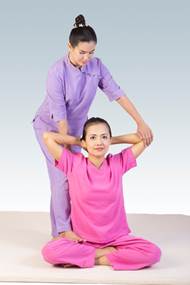 |
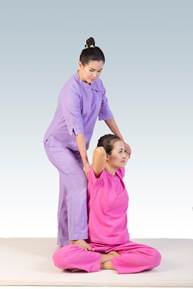 |
Side Twist Stretching Effect
|
Reference
Jan Chaithavuthi and Kanchanoo Muangsiri (2016) Ancient Thai Massage Healing with Prana – Edition 4, Chiang Mai, Thai Massage Book Press
Thai Massage Demonstration at TMC School
A Day of Thai Massage Class at TMC School
